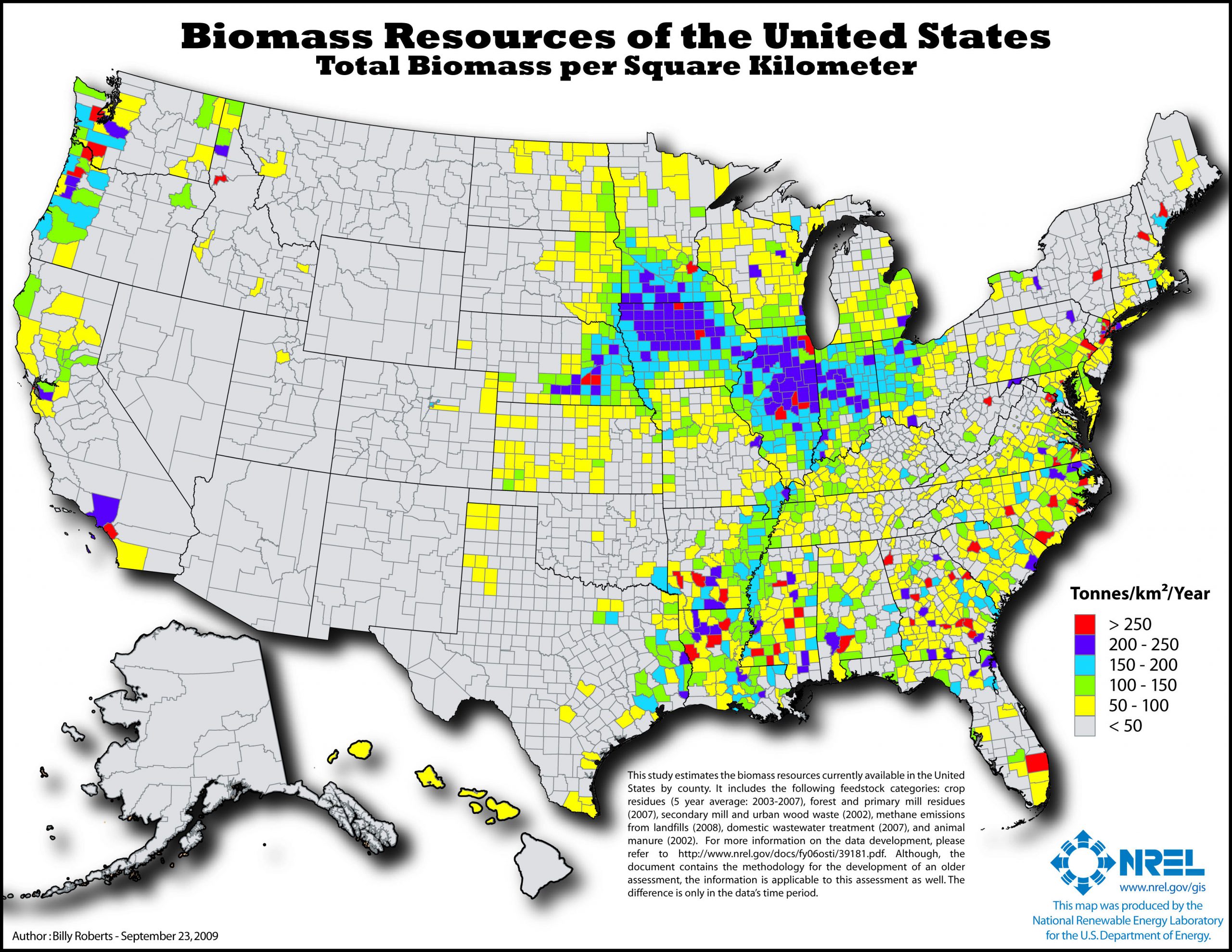Biomass MapsThese maps illustrate the biomass resources available in the United States by county. Biomass feedstock data are analyzed both statistically and graphically using a geographic information system (GIS). The following feedstock categories are evaluated: crop residues, forest residues, primary and secondary mill residues, urban wood waste, and methane emissions from manure management, landfills, and domestic wastewater treatment. Biomass Resources in the United States Total Resources by County – Total Biomass per Square Kilometer – These maps estimate the biomass resources currently available in the United States by county. They include the following feedstock categories: crop residues (5 year average: 2003-2007) forest and primary mill residues (2007), secondary mill and urban wood waste (2002), methane emissions from landfills (2008), domestic wastewater treatment (2007), and animal manure (2002). For more information on the data development, please refer to https://www.nrel.gov/docs/fy06osti/39181.pdf Crop residues – The following crops were included in this analysis: corn, wheat, soybeans, cotton, sorghum, barley, oats, rice, rye, canola, dry edible beans, dry edible peas, peanuts, potatoes, safflower, sunflower, sugarcane, and flaxseed. The quantities of crop residues that can be available in each county are estimated using total grain production, crop to residue ratio, moisture content, and taking into consideration the amount of residue left on the field for soil protection, grazing, and other agricultural activities. Source: USDA, National Agricultural Statistics Service; five-year average: 2003-2007. Forest residues – This category includes logging residues and other removable material left after carrying out silviculture operations and site conversions. Logging residue comprises unused portions of trees, cut or killed by logging and left in the woods. Other removable materials are the unutilized volume of trees cut or killed during logging operations. Source: USDA, Forest Service’s Timber Product Output database, 2007. Primary mill residues – Primary mill residues include wood materials (coarse and fine) and bark generated at manufacturing plants (primary wood-using mills) when round wood products are processed into primary wood products, such as slabs, edgings, trimmings, sawdust, veneer clippings and cores, and pulp screenings. Source: USDA, Forest Service’s Timber Product Output database, 2007. Secondary mill residues – Secondary mill residues include wood scraps and sawdust from woodworking shops — furniture factories, wood container and pallet mills, and wholesale lumberyards. Data on the number of businesses by county was gathered from the U.S. Census Bureau, 2009 County Business Patterns. Urban wood waste Methane emissions from landfills – The methane emissions are estimated for each landfill considering total waste in place, landfill size, and location (arid or non-arid climate), and then aggregated to county level. Note: this dataset doesn’t include all landfills in the United States due to gaps in either precise geographic location or waste in place. Source: EPA, Landfill Methane Outreach Program (LMOP), April 2008. Methane emissions from manure management – The following animal types were included in this analysis: dairy cows, beef cows, hogs and pigs, sheep, chickens and layers, broilers, and turkey. The methane emissions were calculated by animal type and manure management system at a county level. Source: USDA, National Agricultural Statistics Service, 2002 data. Methane emissions from domestic wastewater treatment – The methane emissions are estimated using the methodology from the EPA Inventory of U.S. Greenhouse Gas Emissions and Sinks: 1990-2003. Source: U.S. Census Bureau, 2007 County Population. |

